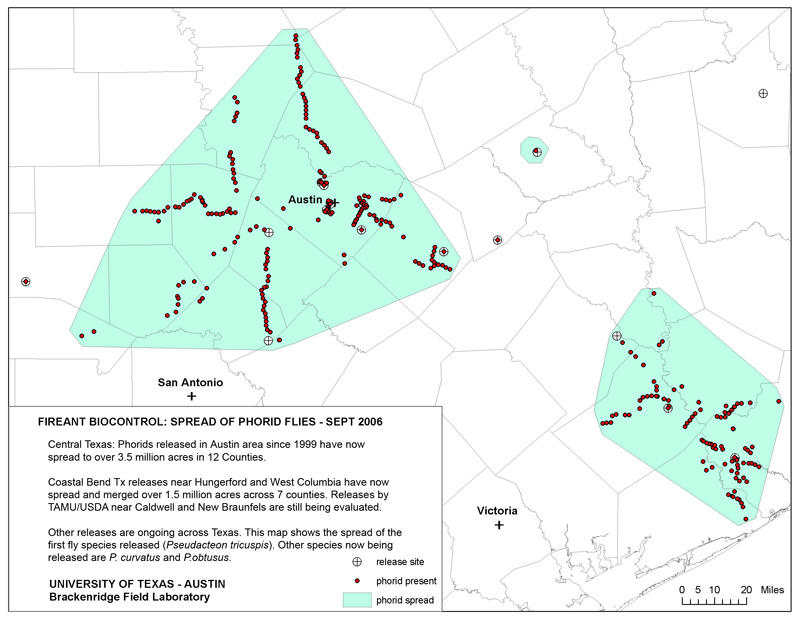 AUSTIN, Texas—Parasitic flies introduced to control red imported fire ants have spread over four million acres in central and southeast Texas since the flies’ introduction in 1999, researchers at The University of Texas at Austin have discovered using new flytraps they developed.
AUSTIN, Texas—Parasitic flies introduced to control red imported fire ants have spread over four million acres in central and southeast Texas since the flies’ introduction in 1999, researchers at The University of Texas at Austin have discovered using new flytraps they developed.
Researchers at the Brackenridge Field Laboratory (BFL) have released multiple species of the parasitic flies, originally from Brazil and Argentina, to control invasive fire ants without pesticides. The fly larvae develop inside the ants and kill their host.
Dr. Ed LeBrun, a researcher at BFL, developed the new flytraps that allowed him to map the spread of the first species of phorid fly successfully introduced. The fly, Pseudacteon tricuspis, was introduced to several locations in Texas beginning in 1999 with BFL in central Austin.
The small traps capture fire ants first by luring them in with ants from a disturbed mound. The flies follow the ants into the traps and then become stuck on strips of flypaper when they take a break from attacking their victims. Researchers place traps around fire ant mounds along roads and analyze the flies they catch.
They have found the introduced phorid flies attacking imported fire ants in more than 12 counties and 3.5 million acres in Central Texas and seven counties and 1.5 million acres in the Coastal Bend region of Texas.
Phorids got a slow start after introduction due to drought in Texas from 1999-2001, says Dr. Larry Gilbert, director of the fire ant research program and professor of integrative biology, but they are now spreading three-to-10 miles per year from initial introduction sites.
In addition to Brazilian and Argentinean strains of P. tricuspis, two other phorid species were introduced since 2004, and Gilbert says the smallest one, P. curvatus, is also on the march.
Gilbert says these initial successes should be seen as "getting to first base" in the attempt to control red imported fire ants with phorid flies.
In their native Argentina, where Gilbert and his collaborators study the ants and flies, fire ants are assaulted by as many as 12 different kinds of phorid fly in an area smaller than a football field.
"No single phorid species will be a magic bullet," he says.
Fire ants are not typically pests or even common in South America in large part because of harassment by the phorid flies. In the presence of these flies, ants have difficulty retrieving food, having mating flights or rescuing their larvae after mounds become disturbed by animals such as armadillos during the day.
“It's not just because these tiny flies are numerous, it’s also because they are diverse in kinds, coming after worker ants in many different ways at once,” says Gilbert. “Different phorids specialize on small or large workers, on distinct chemicals laid down by the ants on trails, on time of day and on season and so forth. Our goal is to copy what we believe to be nature's complex control system.”
Gilbert and his colleagues are looking at the fire ant-fly relationship in parts of Argentina that are similar to habitats in Texas.
"It is rewarding to see the first species expanding over more than four million acres of Texas,” says Gilbert, “but we've failed miserably in parts of Texas, like South Texas, to which these first phorids apparently cannot adapt. That's why we are focusing research efforts in parts of Argentina that look exactly like the South Texas brush country."
Gilbert is also working with ranchers to help them learn how to infest their own fire ant colonies with phorid flies. He began the initiative in 2005 with ranchers from Bee County, Texas.
To introduce phorid flies themselves, people can bring ants from their property to high-density areas of phorids and return the ants to their property carrying phorid eggs inside them.
“People accidentally move fire ants around all the time,” says Gilbert, “and now they can help speed up the spread of phorid flies on purpose by moving ants containing phorid eggs."
The new flytraps will help BFL researchers identify where the latest phorid hotspots exist so that landowners can know where to bring fire ants from their property.
Recently, the Texas Organization of Wildlife Management Associations adopted the initiative and plans to help promote the spreading of phorids by private ranching and wildlife groups.

















Comments 1
Come up a little north/east. Here in the outskirts of Florence, the fire ants are thriving just fine. Especially after a good rain, they pop up and life is miserable. Most people stay indoors because of these. They actually are so bad it alters our living conditions. Forget lawn ornaments, stepping stones, outbuildings, etc. I'm sure you get the idea. I, for one, hate the itchy hard blisters they leave behind. It can drive you insane.